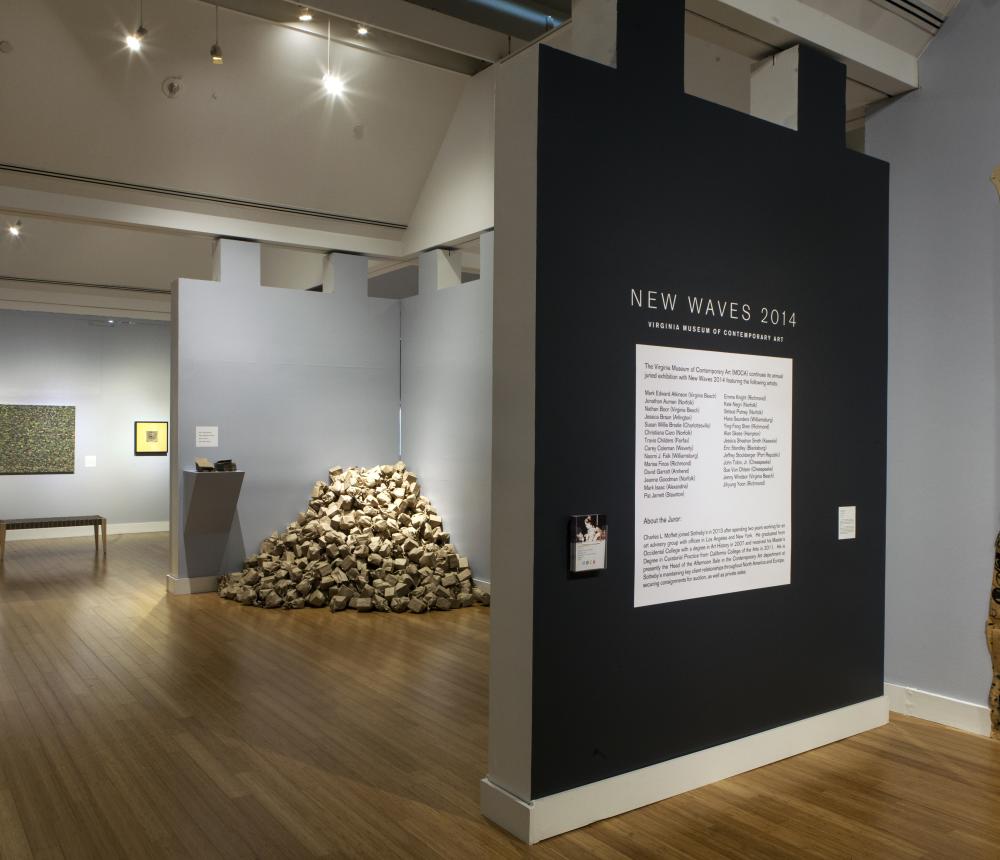
The work is reminiscent, though speaks in its own language, of Barbara Walker, a British artist who uses erasure and embossing to comment on who is seen and remembered from British history. In Lady and Gentleman, the silhouettes of early American men and women are Dremel-erased, leaving only their white silhouettes and occasional delicate gouges. On a nearby wall, two bodies of work by Hollie Lykos explore the presence of absence by taking a Dremel tool to the decorated surfaces of vintage mass-produced souvenir plates. As such, the installation suggests at once a warm presence, a ghostly absence, the fragmented compartmentalization of memory, and the role of time. The artist culled these images from family photo albums of Holocaust survivors in Kansas City. Through programmed lighting and a process known as lithophane in which an image is etched into very thin porcelain and only visible when backlit, pre-WWII sepia-toned photographs intermittently light up on the sides of selected vessels. A sign near wipes and gloves discreetly located on an adjacent wall, invites visitors to touch and, in fact, it is in part through viewer interactivity that the installation comes to life. The ceramic teapots, stacks of cups and saucers, creamers, and sugar bowls speak to a refined life of simple, ritualistic domestic pleasures. The title refers both to music in which a theme is repeated and to psychiatry in which one loses an attachment to one’s identity. In the center of the gallery, dozens of pieces of Rae Stern’s chalky white bisqueware sit atop a choreographed hodgepodge of chalky gray furniture in Fugue. Glasses, a glue gun, and a guitar pick join hundreds of other objects in this anthropological conglomeration of one person’s life mediated by objects, as mundane as they are meaningful. Rendered both in relief and three dimensions-to scale and not-all the many objects we associate with a loved one come together in a way in which, as cliché as it might sound, the sum is greater than its parts. There, 365 objects sculpted in unglazed terracotta arranged in a monumental oval, read as the artifacts of a life. Pattie Chalmers’ installation Every Day I Think of You commands the back wall of the Main Gallery.


It bears witness to the processes that produce it.

Clay, the most malleable of media, “remembers” the touch and pressure that forms it. And as is so often the case with contemporary art, the medium is the message, as Marshall McLuhan famously stated. Each of the bodies of work in this show metaphorically embody, through their diverse approaches to multicomponent formats, the constructive nature of memory. It has been theorized that memory is a constructive process, that is, that our memories are shaped, at least in part, by what we believe, what we perceive, and what we retrieve.
#Virginia moca driver
Here’s my take on each.Ĭurated by Alison Byrne, Virginia MOCA’s Deputy Director of Exhibitions and Education, this exhibition presents the work of six artists for whom memory is a driver of their creative output in clay, whether earthenware, porcelain, terracotta, or found objects: Pattie Chalmers, Roberto Lugo, Hollie Lykos, Jiha Moon, Rae Stern, and Ehren Tool. (Cedric Baker’s Aunt Lou won Best of Show for the Made in VA exhibition.)Ī trio of new winter exhibitions is arguably Virginia Museum of Contemporary Art’s most captivating in years.


 0 kommentar(er)
0 kommentar(er)
